

Several works on view at “Sam Spratt: The Monument Game” at the Docks Cantiere Pietro Cucchini in Venice.
Image courtesy 1OF1. Photography by Anna Blubanana studio.
|
|
With 2023 upon us at last, we’re looking ahead at what we might expect from the year to come. If 2022 was the year of rising stars like Anna Weyant and Christina Quarles, who will be the names to know in the New Year?
To make some predictions, we asked leading critics, curators, artists, and advisors to each pick the one artist they think is poised to make break out in a major way this year.
Here’s who they chose.
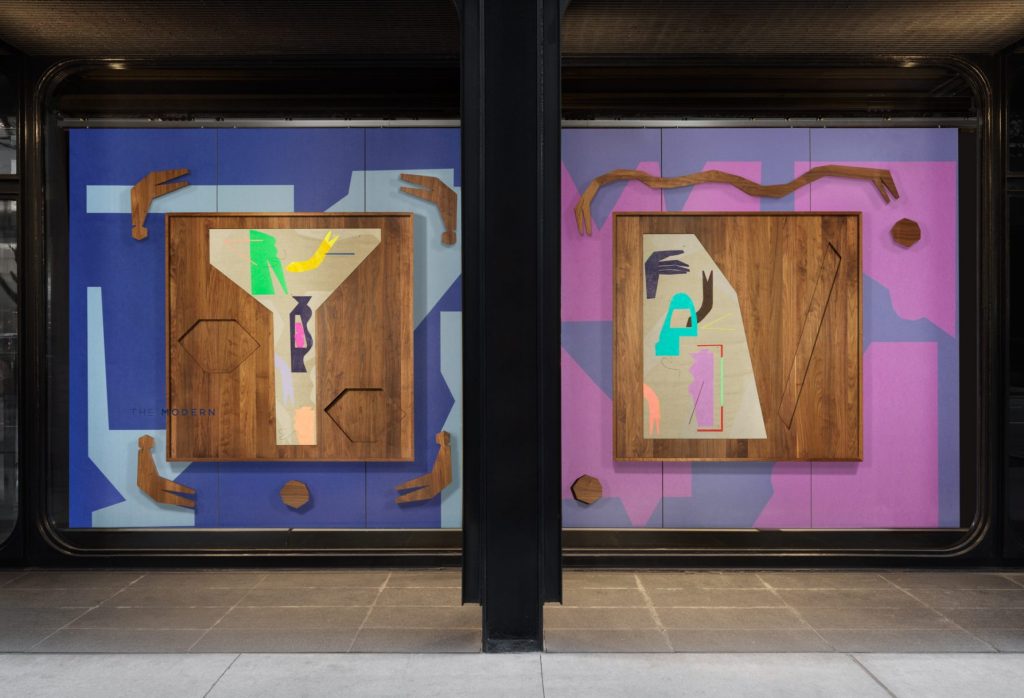
Installation view: “The Modern Window: Caroline Kent,” Museum of Modern Art, New York. October 29, 2022 – October 2023. Photo: Dan Bradica. Courtesy the artist and Casey Kaplan, New York.
“After making several strong gallery and project presentations, and currently gracing MOMA’s “Modern Window,” Caroline Kent is now in pole position for a strong critical contextualization. Harnessing the palette and deep spatial instincts of the Bauhaus, Kent’s 21st-century abstractions are imbued with a sense of embodiment, wordliness, and clue us in to the relationships between power and language.”
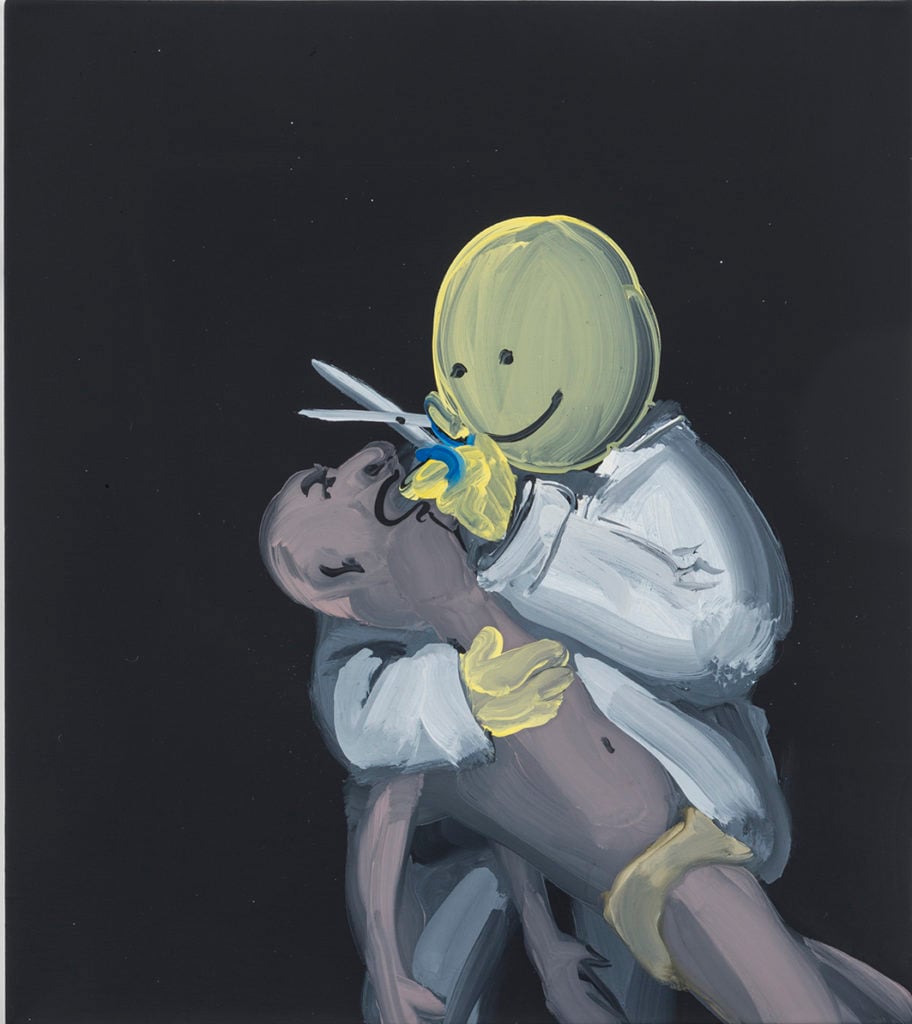

Tala Madani, Love Doctor (2015). Collection of Christina Papadopoulou. Photo courtesy Josh White.
“She is irreverent, savage, filthy, and very funny. Plus she is a great animator and painter. I love everything she does. I’ve been following her work for years.”
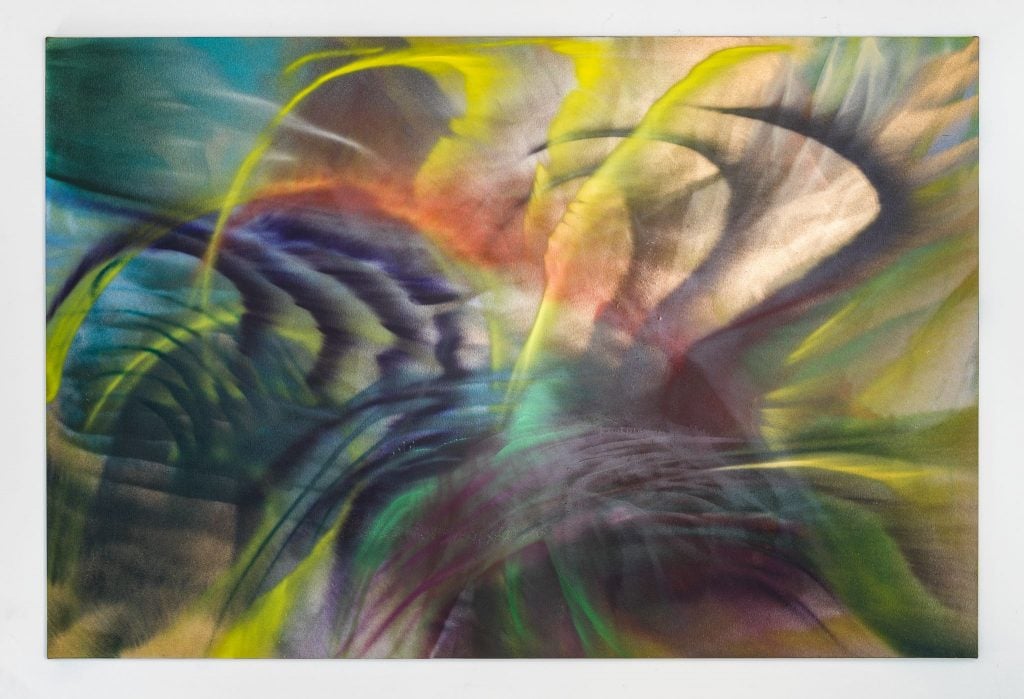

Andrea Marie Breiling, Emma (2022). Courtesy of the artist and Almine Rech. Photo: Adam Reich Photography.
“It’s inspiring to see a painter push her work forward as quickly as Andrea Marie Breiling has been doing. I didn’t get to Miami to see her show ‘Ribbons’ at Villa Paula, timed to coincide with the Art Basel Miami fair, but from what I can tell, her spray-painted swoops and swirls have taken even more volume, depth, and drama. The spiritual aspiration of an Agnes Pelton meets the blunt physicality of a Willem de Kooning in a synthesis that’s totally of the moment.”
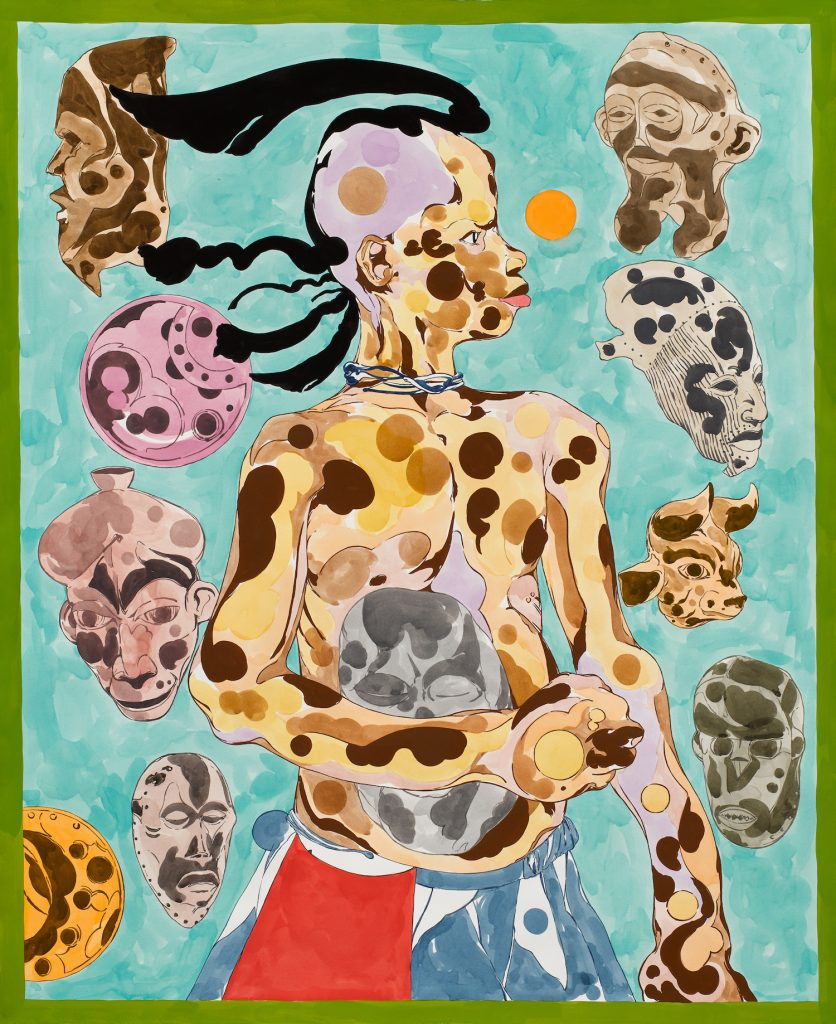

Richard Ayodeji Ikhide, Boju ti ara (Masks of Self), 2022. Image courtesy of the artist and Victoria Miro, London, ©Richard Ayodeji Ikhide.
“The Nigerian-born, London-based artist Richard Ayodeji Ikhide has been creating a cosmology of archetypes celebrating object- and image-makers and creators in our society: observers, storytellers, alchemists, artists, and inventors. I discovered Richard’s large-scale watercolor works through the non-profit organization V.O. Curations early in the pandemic, and it has been amazing to see him continue to expand his practice. He just completed a suite of extraordinarily beautiful and complex watercolors for a Victoria Miro Gallery online project, and I think he is definitely an artist to watch!”
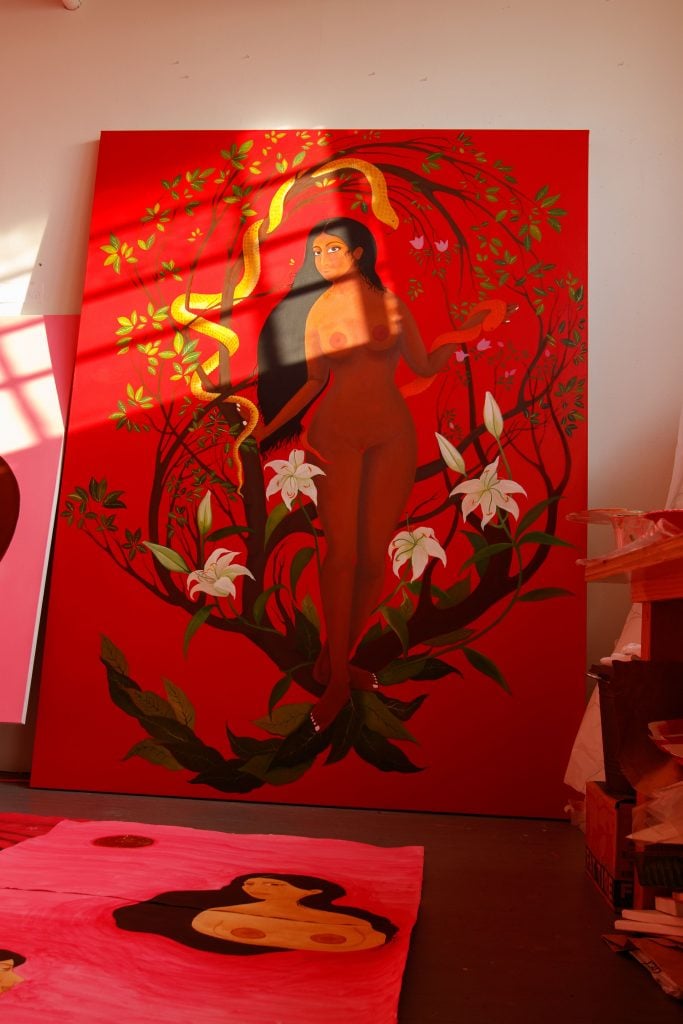

One of Hiba Schahbaz’s large-scale oil paintings. Photo courtesy of the artist.
“I have been following Hiba’s work for several years—in full disclosure I do not own any—and her development from works on paper to large oils on canvas is significant. Her use of the female body, particularly through the lens of Pakistani culture and a pivot away from the traditional miniature, is new ground, at to least my eyes. All she needs for her next step in the art world/market is a serious New York-based gallery to help her enter the conversation.”
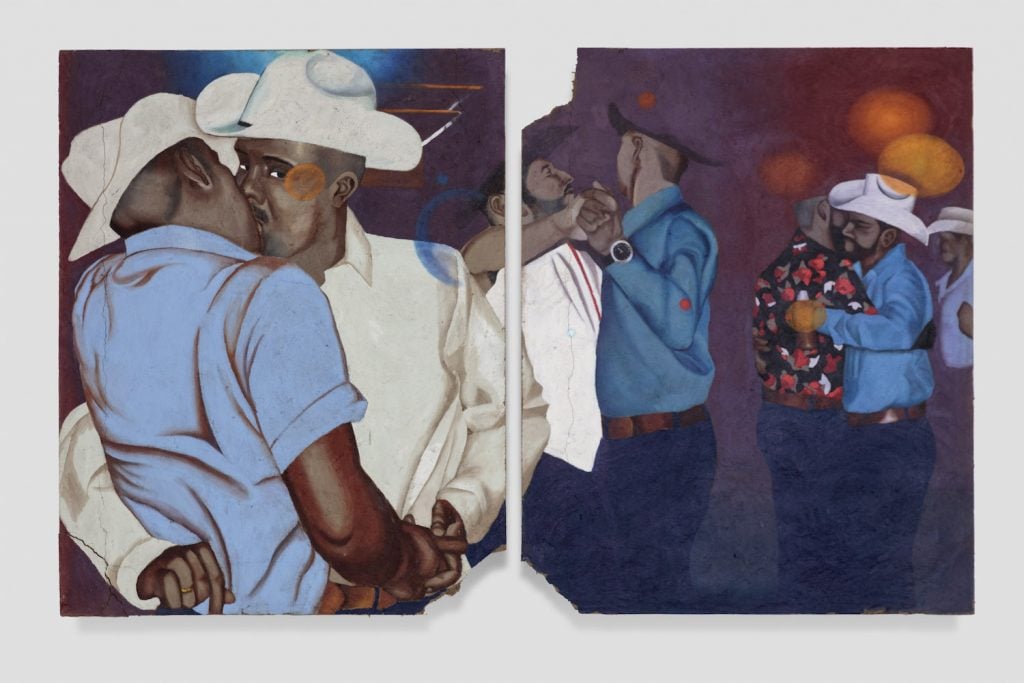

Rafael Esparza, “Shattered Glass,” curated by Melahn Frierson and AJ Girard, Jeffrey Deitch, Los Angeles, (2021)
Photo by Joshua White
“There are three basic ways I think of an artist ‘breaking out:’ in their work, by recognition, or by the attentions of the market. Rafa Esparza, an artist of mature vision and healthy and growing support of museums and private collectors, is likely to become more nationally visible with upcoming exhibitions at New York’s Artist’s Space and the San Francisco Museum of Art. I especially admire his work for its accessibility and truthfulness, for its presence, both commanding and gentle, and for its natural, complex, and essential fusion of the personal and political, and for his propensity to ‘brown the white cube.’ Working in performance, painting, sculpture, and installation, while not beholden to the conventions of any idiom, his work embodies the complexity of identity through the interwoven elements of his identity, while also critiquing conventions of art and society.”
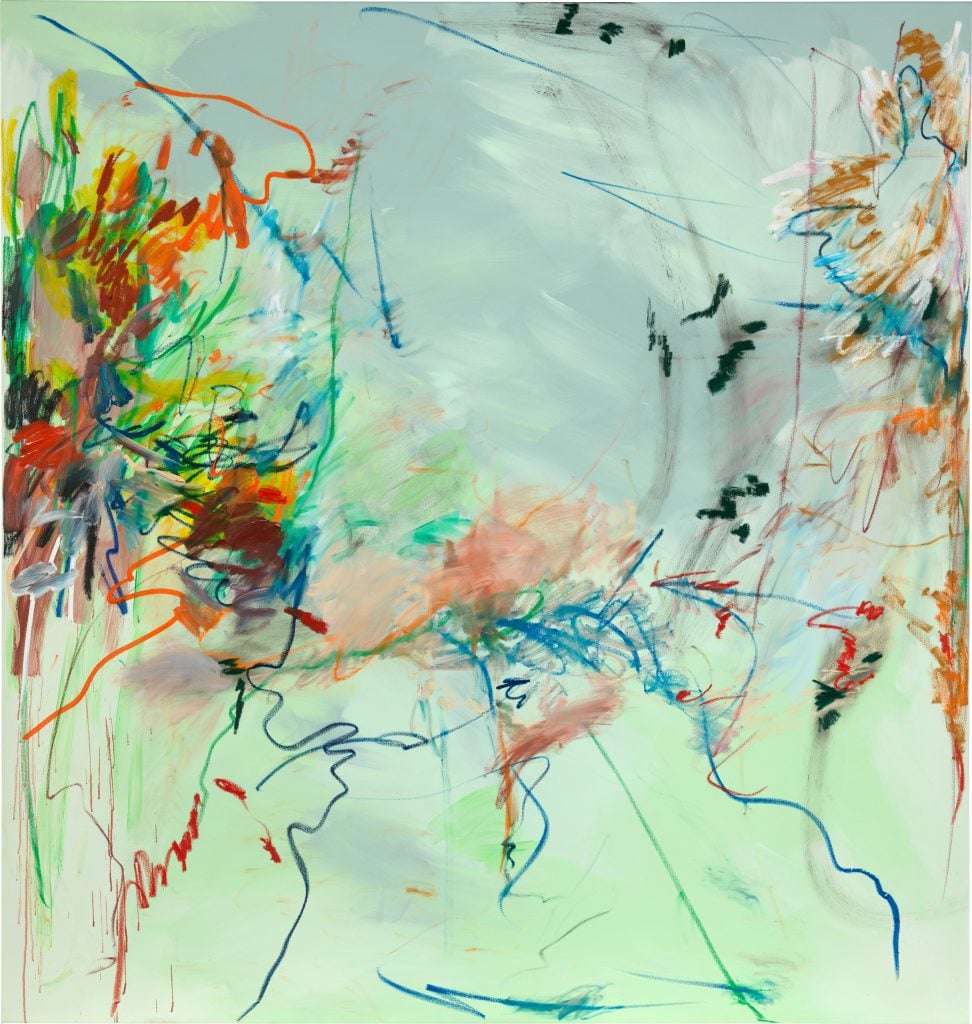

Xiyao Wang, Arabesque on vert menthe (2021), sold for HK$478,000 ($61,532) at Phillips Hong Kong day sale on November 30, 2022. Courtesy Phillips.
“My pick is Xiyao Wang, a Berlin-based Chinese female artist that was featured in our day sale this season. For me, she is representative of the new generation of abstract painters and you can certainly see parallels of the lyrical quality of Cy Twombly merged with inspiration from global mass culture, electronic music, and all the media that has been of influence to millennials and Gen Z. She primarily works on very large-scale paintings in which there are many gestural elements that evoke landscapes, bodies and movements.”


Annie Morris, Installation view, courtesy of Chateau La Coste ©Stéphane Aboudaram | WE ARE CONTENT(S) 2022.
“I have been following Annie’s work for some time, and have long admired its ability to teeter on the edge between substance and fragility, rendering the highly personal into a universal language of loss. But there is something about her relatively recent use of bronze as one of her primary mediums for her ‘Stack’ sculptures that I feel has elevated her practice to a new level. I loved her entire show at Chateau La Coste this summer, but it was the one outdoor work, a monumental bronze ‘Stack,’ that I feel emphatically declares Annie’s place within contemporary art history. Standing at six meters tall in a grassy field, just across the way from an iconic Louise Bourgeois Spider, the two works seem to be in conversation with each other, the bold declarations of artists of different backgrounds and generations united in their meditations on motherhood and mourning.”
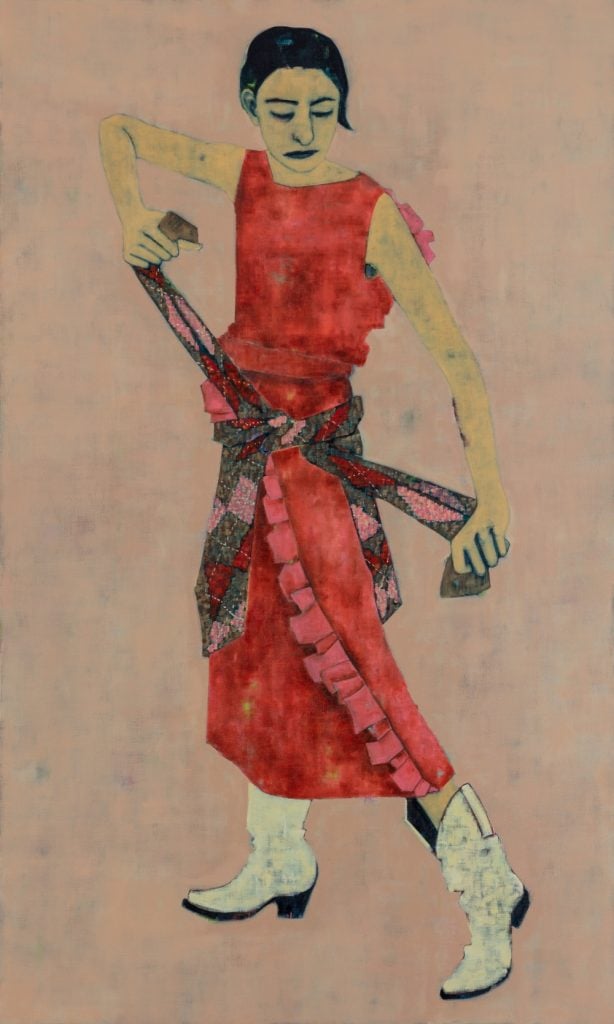

Sara Berman, Untitled (2022). Photo courtesy of Kristin Hjellegjerde Gallery.
“My stand-out artist for 2023 is Sara Berman, a London-based artist who transitioned from a successful fashion career to the art world when she graduated from Slade in 2016 with an MFA in painting. Berman’s background in fashion has influenced her visual arts practice through the use of various textures, layers, mathematical geometry, pattern, and materiality. In her work, Berman examines how people see and define themselves through the relationships with their clothes, belongings, and the spaces they occupy. The character in Sara Berman’s work is inspired by the trope of the female Harlequin in her ascribed role of the Trickster Whore. Through this character, Berman explores space and the role of the feminine within it. I find her works relevant, powerful and evocative of the times we live in.
I first discovered her work at Kristin Hjellegjerde Gallery, where she has two solo shows coming up in 2023 and we will also be unveiling two new works especially created for Eye of the Collector in May 2023.”
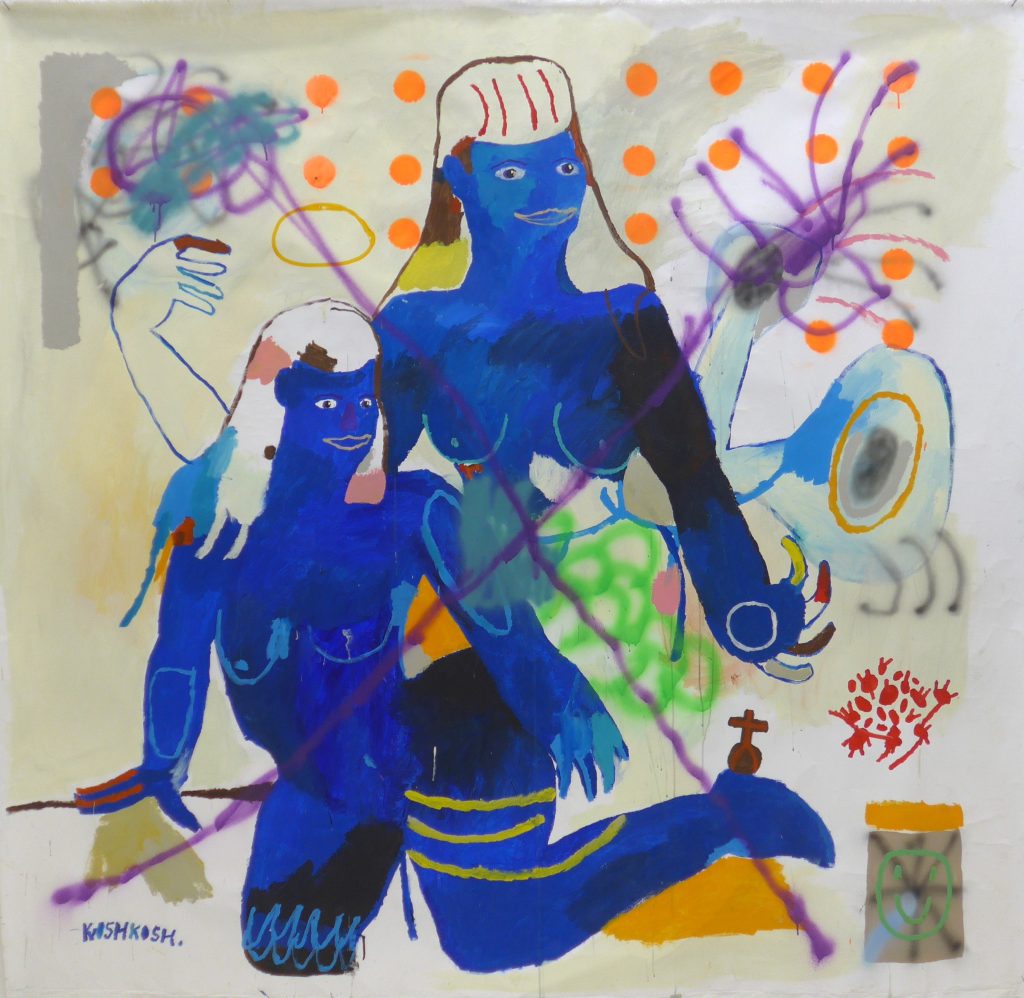

Nicholas Koshkosh, Untitled (2020). Photo courtesy of Jens-Peter Brask.
“The artist I predict will have an excellent 2023 is the talented contemporary Ukrainian artist Nicholas Koshkosh (b. 1995). Koshkosh lives and works in Kiev. In recent years, he has gained international recognition for his colorful, figurative, expressive paintings. Koshkosh has found his own unique expression and aesthetic language that spans a multitude of references to biblical narratives, mythical stories and—currently—interpretations of his first-hand experiences and feelings related to the ongoing war and invasion of his home country Ukraine. Old tales are combined with cultural signs from the Slavic regions, fairy tale references and contemporary pop culture elements. Koshkosh’s works are often shaped by an underlying critical attitude toward ongoing political issues. I foresee a bright future for Koshkosh as an artist who artistically provides and creates a space for reflection and immersion in art.”
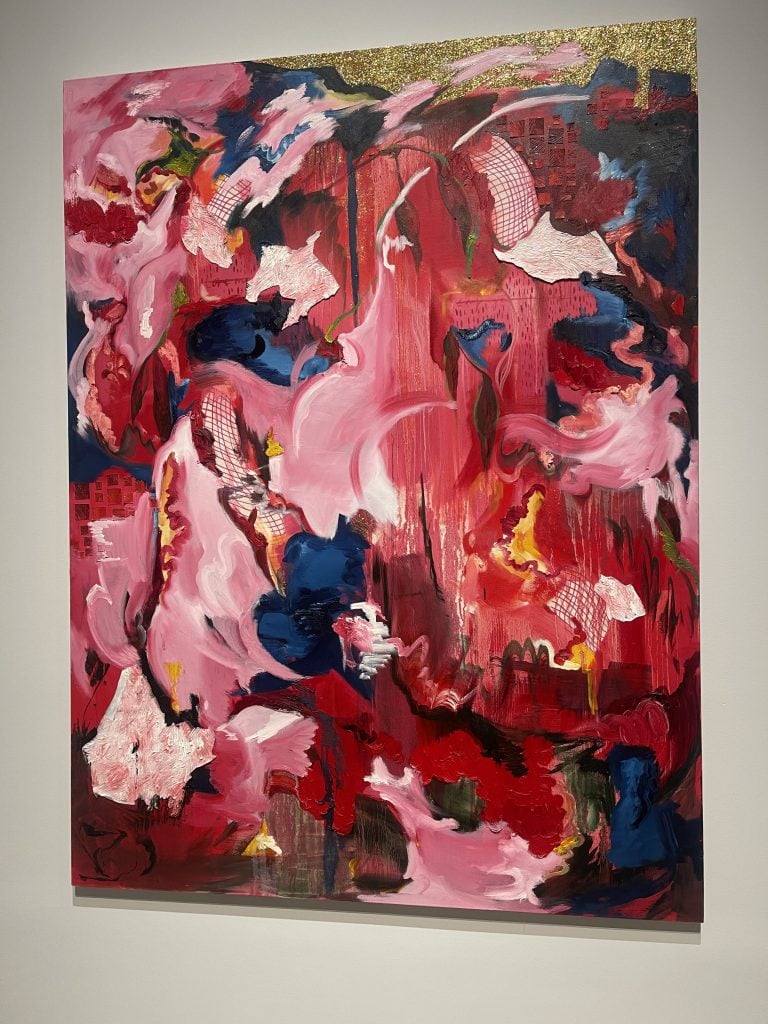

Michaela Yearwood-Dan, It’s All Happening, 2021. Photo courtesy of Debi Wisch.
“I was at a show at the Scottsdale Museum of Contemporary Art over Thanksgiving featuring work by many of today’s most headline grabbing artists and this was the painting that literally stopped me in my tracks because it is so drop-dead gorgeous, luscious, layered, seductive, and fresh. Then one of my most trusted, intrepid, influential art collector friends mentioned Michaela as someone that I need to know. I have been on a deep dive ever since. She is young, smart, talented and has a visual language that’s unique—and the paintings are stunning.”
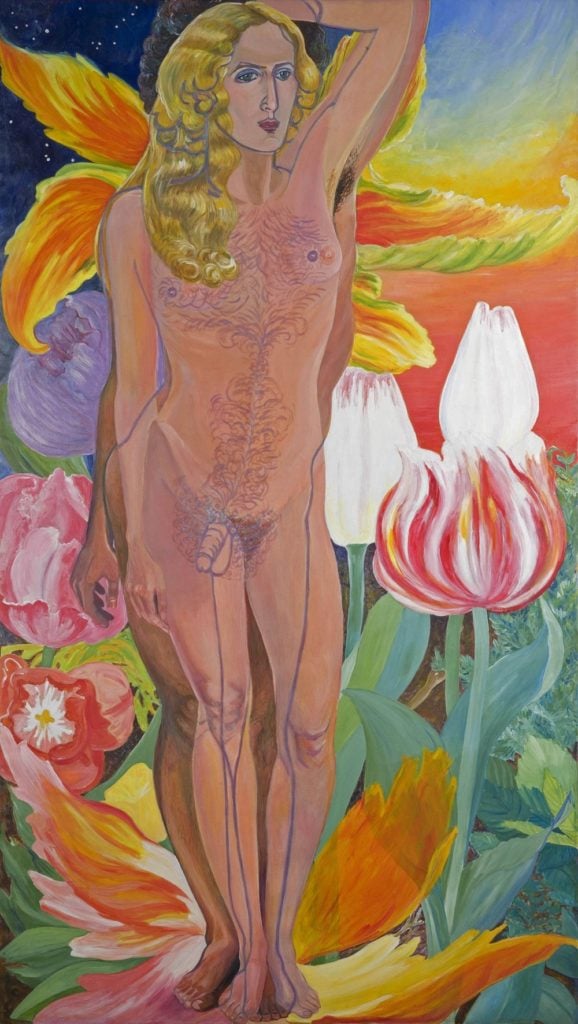

Sylvia Sleigh, Lilith (1976). Photo by Karen Mauch Photography, © Friends of Sylvia Sleigh; Rowan University Art Gallery, Sylvia Sleigh Collection.
“As a figurative painter who came to prominence in New York in the 1960s and ’70s, Sleigh is massively undervalued and under-appreciated by the broader collecting world while maintaining a cult figure status among art world cognoscenti. It’s time for people to see her incredible work and learn of her important contributions to painting and the feminist art movement.”
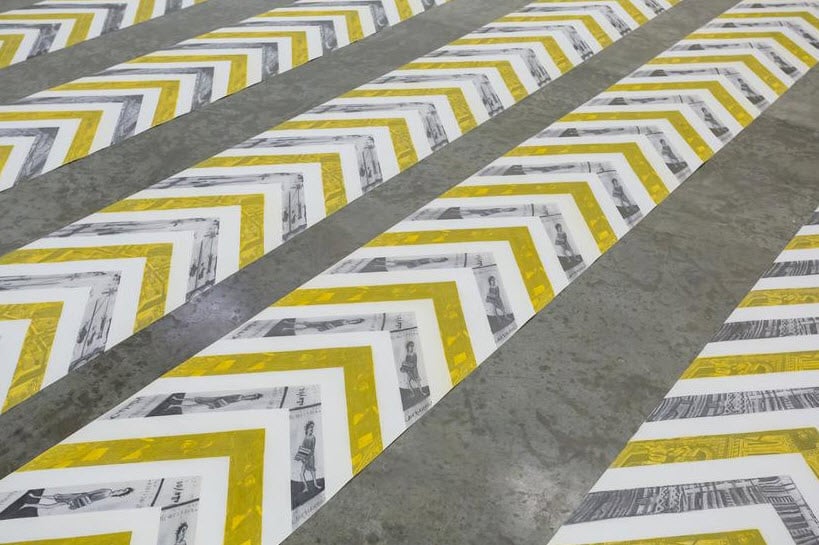

Hera Büyüktaşçıyan, Everflowing Pool of Nectar (detail view) (2017). Courtesy of Green Art Gallery.
“Hera Büyüktaşcıyan has been steadily rising above career milestones, mostly recently with new commissions for the New Museum’s Triennial and the 2022 Biennale of Sydney. Although her works have been acquired by Tate Modern and Centre Pompidou recently, 2023 will mark her first museum solo of new works in a yet-to-be-announced presentation. Watch this space.”
Follow Artnet News on Facebook:
Want to stay ahead of the art world? Subscribe to our newsletter to get the breaking news, eye-opening interviews, and incisive critical takes that drive the conversation forward.





[unable to retrieve full-text content]
Biggest Indigenous art collection CTV News Barrie





Source link


Welcome to the Art Angle, a podcast from Artnet News that delves into the places where the art world meets the real world, bringing each week’s biggest story down to earth. Join us every week for an in-depth look at what matters most in museums, the art market, and much more, with input from our own writers and editors, as well as artists, curators, and other top experts in the field.
The art press is filled with headlines about trophy works trading for huge sums: $195 million for an Andy Warhol, $110 million for a Jean-Michel Basquiat, $91 million for a Jeff Koons. In the popular imagination, pricy art just keeps climbing in value—up, up, and up. The truth is more complicated, as those in the industry know. Tastes change, and demand shifts. The reputations of artists rise and fall, as do their prices. Reselling art for profit is often quite difficult—it’s the exception rather than the norm. This is “the art market’s dirty secret,” Artnet senior reporter Katya Kazakina wrote last month in her weekly Art Detective column.
In her recent columns, Katya has been reporting on that very thorny topic, which has grown even thornier amid what appears to be a severe market correction. As one collector told her: “There’s a bit of a carnage in the market at the moment. Many things are not selling at all or selling for a fraction of what they used to.”
For instance, a painting by Dan Colen that was purchased fresh from a gallery a decade ago for probably around $450,000 went for only about $15,000 at auction. And Colen is not the only once-hot figure floundering. As Katya wrote: “Right now, you can often find a painting, a drawing, or a sculpture at auction for a fraction of what it would cost at a gallery. Still, art dealers keep asking—and buyers keep paying—steep prices for new works.” In the parlance of the art world, primary prices are outstripping secondary ones.
Why is this happening? And why do seemingly sophisticated collectors continue to pay immense sums for art from galleries, knowing full well that they may never recoup their investment? This week, Katya joins Artnet Pro editor Andrew Russeth on the podcast to make sense of these questions—and to cover a whole lot more.
Follow Artnet News on Facebook:
Want to stay ahead of the art world? Subscribe to our newsletter to get the breaking news, eye-opening interviews, and incisive critical takes that drive the conversation forward.
Digital artist Sam Spratt is living the artist’s dream. This week, he celebrated the opening of “The Monument Game,” his first-ever art show. But it wasn’t a group show in some DIY space in New York, where he is based, like so many artists typically start out, but a solo exhibition in Venice, during the art world’s biggest event of the year—the Venice Biennale. How did Spratt–a virtually unknown name in the art world–make such a tremendous leap? With a little help from his friends, of course, including Ryan Zurrer, the venture capitalist turned digital art champion.
“Something the capital ‘A’ art world doesn’t recognize is the power of the collective, it sometimes leans into the cult of the individual,” Ryan Zurrer told ARTnews during a preview of the opening. “But this show is supported by the entire community around Sam.”
Spratt’s Venice exhibition was put on by 1OF1 Collection, a “collecting club” set up by Zurrer to nurture digital artists working in the NFT space. Since its launch in 2021, 1OF1 has been uniquely successful in bridging the gap between the art world and the Web3 community. Last year, 1OF1 and the RFC Art Collection gifted Anadol’s Unsupervised – Machine Hallucinations – MoMA to the museum, after nearly a year on view in the Gund Lobby. Zurrer also arranged the first museum presentations of Beeple’s HUMAN ONE, a seven-foot-tall kinetic sculpture based on video works, showing it first at Castello di Rivoli in Italy and the M+ Museum in Hong Kong, before sending it to Crystal Bridges Museum of American Art in Arkansas.
With “The Monument Game,” Zurrer is once again placing digitally native art at the center of the art world. While Anadol and Beeple had large cultural footprints prior to Zurrer’s patronage, Spratt is far earlier in his career. But, what attracted Zurrer, he said, was the artist’s shrewd approach to building a dedicated, participatory audience for his work. He did so by making his art a game.
“When I first started looking at NFTs, I spent a long time just figuring out who the players were,” Spratt told ARTnews. “The auctions were like stories in themselves, I could see people’s friends bidding, almost ceremonially, to give the auction some energy, and then other people would come in, and it would get competitive, emotional.”
Spratt released his first three NFTs on the platform SuperRare in October 2021. The sale of those works, the first from his series LUCI, was accompanied by a giveaway of a free NFT to every person who put in a bid. Zurrer had been one of those underbidders (for the work Birth of Luci). While Spratt said the derivative NFTs were basically worthless, he wanted to give something back to each bidder. Zurrer, and others it seems, appreciated the gesture and Spratt quickly gained a following in the Web3 space. The offerings he gave, called Skulls of Luci, became Sam’s dedicated collectors that now go by The Council of Luci. 47 editions were given out and Spratt held back three.
All the works from LUCI are on view at the Docks Cantiere Cucchini, a short walk from the Arsenale, past a rocking boat that doubles as a fruit and vegetable market and over a wooden bridge. Though NFTs typically bring to mind glitching screens and monkey cartoons (ala Bored Ape Yacht Club), the ten works on view depict apes in a detailed, painterly style and emit a soft glow. Taking cues from photography installations, 1OF1 ditched screens in favor of prints mounted on lightboxes.
“We don’t want it to look like a Best Buy in here,” said Zurrer.


Several works on view at “Sam Spratt: The Monument Game” at the Docks Cantiere Pietro Cucchini in Venice.
Image courtesy 1OF1. Photography by Anna Blubanana studio.
Each work represents a chapter in a fantasy world that Spratt dreamed up. Though there’s no book of lore to refer to, there seems to be some Planet of the Apes story at play in which an intelligent ape lives alongside humans, babies, and ape-human hybrids. Spratt received an education in oil painting at Savannah College of Art and Design and he credits that technical training with his ability to bring warmth and detail to the digital works. He and the team often say that his art historical references harken to Renaissance and Baroque art, though the aesthetics—to my eye—seem to pull from commercial illustration and concept art. That isn’t too surprising given that this was the environment that Spratt started off in after graduating SCAD in 2010.
“After school I was confronted with the reality that for a digital artist the only path was commercial,” Spratt said.
He did quite well on that path, producing album covers for Childish Gambino, Janelle Monae, and Kid Cudi and bagging clients like Marvel, StreetEasy, and Netflix. Spratt also enjoys a huge audience of fans who have followed him as he’s migrated from Facebook to Tumblr to Twitter and Instagram, posting his hyper-realistic fan-art on each platform. Despite the apparent success, Spratt spoke of the work with bitterness.
“I was a gun for hire. A mimic, hired to be 30% me and 70% someone else,” he said.
Spratt’s personal life blew up when he turned 30 and he traced some of the mistakes he made in his relationships with the fact that he had spent so much of his career “telling other people’s stories.” NFTs seemed like a way out of commercial illustration and a way into an original art practice.
For his latest piece in the LUCI series, Spratt digitally painted a massive landscape set in this ape-human world titled The Monument Game. For the piece, Spratt initially sold NFTs that would turn 209 collectors into “players” (since another edition of 256 NFTs was given to the Council to “curate” new champions”). Each player would then be allowed to make an observation about the painting. The Council of Luci would vote on which three observations were best, and those three Players would receive one of the Skulls of Luci NFTs that Spratt held back. By creating these tiers of engagement, with his Council and player structure, Spratt pushes digital collectors to give the kind of care to his work that more traditional collectors do.


A work at “Sam Spratt: The Monument Game” at the Docks Cantiere Pietro Cucchini in Venice.
Image courtesy 1OF1. Photography by Anna Blubanana studio.
“Jeff Koons said that the average person looks at a work of art for twenty seconds,” Lukas Amacher, 1OF1’s Artistic Director and the curator of the show, told ARTnews. “Sam has found a way to get people to engage in his work for much longer.”
The game Spratt has designed for the Venice exhibition might seem too gamified to fit the art world’s notion of art, but as Amacher and Zurrer suggest, in the Web3 environment, value is built by finding alternative ways to create investment and attention in what are typically immaterial digital artifacts. And it’s working. Thus far, the LUCI series has generated $2 million in primary sales and about $4 million in additional secondary volume. The challenge now, as it has been for the past three years, is to see if art’s gatekeepers will take this work seriously.
At the presentation of The Monument Game in Venice, an observation deck, built by platform Nifty Gateway, sits in front of the mounted work. Participants can click on the painting on the screen and write down their observations of the work in front of them, no NFT required. The first observation came from star curator Carolyn Christov-Bakargiev, the director of Castello di Rivoli and curator of Documenta 15: a tribute to art dealer Marian Goodman. The second was from Zurrer. Who’s next?
“Sam Spratt: The Monument Game” is on view until June 21 at the Docks Cantiere Pietro Cucchini in Venice.
DJT Stock Rises. Trump Media CEO Alleges Potential Market Manipulation. – Barron's
Trump Media alerts Nasdaq to potential market manipulation from 'naked' short selling of DJT stock – CNBC
Private equity gears up for potential National Football League investments – Financial Times




Type 2 diabetes is not one-size-fits-all: Subtypes affect complications and treatment options – The Conversation
DJT Stock Jumps. The Truth Social Owner Is Showing Stockholders How to Block Short Sellers. – Barron's
Tofino, Pemberton among communities opting in to B.C.'s new short-term rental restrictions – Vancouver Sun
A sunken boat dream has left a bad taste in this Tim Hortons customer's mouth – CBC.ca




Start time set for Game 1 in Maple Leafs-Bruins playoff series – Toronto Sun